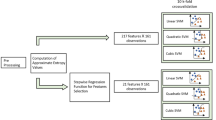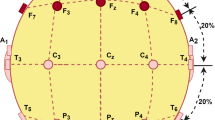Abstract
The purpose of this study is to investigate the application of sample entropy (SampEn) measures to electrophysiological studies of single and dual tasking performance. The complexity of short-duration (~s) epochs of EEG data were analysed using SampEn along with the surrogate technique. Individual tasks consisted of an auditory discrimination task and two motor tasks of varying difficulty. Dual task conditions were combinations of one auditory and one motor task. EEG entropies were significantly lower in dual tasks compared to that in the single tasks. The results of this study have demonstrated that entropy measurements can be a useful alternative and nonlinear approach to analyzing short duration EEG signals on a time scale of seconds.
Preview
Unable to display preview. Download preview PDF.
Similar content being viewed by others
References
Pashler, H.: Dual-Task Interference in Simple Tasks: Data and Theory. Psychological Bulletin 116(2), 220–244 (1994)
Schumacher, E.H., Seymour, T.L., Glass, J.M., Fencsik, D.E., Lauber, E.J., Kieras, D.E., Meyer, D.E.: Virtually perfect time sharing in dual-task performance: Uncorking the central cognitive bottleneck. Psychological Science 12(2), 101–108 (2001)
Hsieh, S., Yu, Y.-T.: Switching between simple response-set: inferences from the lateralized readiness potential. Cognitive Brain Research 17, 228–237 (2003)
Theiler, J., Eubank, S., Longtin, A., Galdrikian, B., Farmer, J.D.: Testing for nonlinearity in time-series - the method of surrogate data. Physica D 58, 77–94 (1992)
Richman, J.S., Moorman, J.R.: Physiological time-series analysis using approximate entropy and sample entropy. Am. J. Physiol. 278, H2039–H2049 (2000)
Monsell, S.: Task switching. Trends in Cognitive Science 7(3), 134–140 (2003)
Pijn, J.P., van Neerven, J., Noest, A., Lopes da Silva, F.H.: Chaos or noise in EEG signals: dependence of state and brain side. Electroen. Clin. Neurophysiol. 79, 371–381 (1991)
Author information
Authors and Affiliations
Editor information
Editors and Affiliations
Rights and permissions
Copyright information
© 2005 Springer-Verlag Berlin Heidelberg
About this paper
Cite this paper
Zhang, T., Tang, X., Yang, Z. (2005). Comparison of Complexity and Regularity of ERP Recordings Between Single and Dual Tasks Using Sample Entropy Algorithm. In: Wang, L., Chen, K., Ong, Y.S. (eds) Advances in Natural Computation. ICNC 2005. Lecture Notes in Computer Science, vol 3610. Springer, Berlin, Heidelberg. https://doi.org/10.1007/11539087_108
Download citation
DOI: https://doi.org/10.1007/11539087_108
Publisher Name: Springer, Berlin, Heidelberg
Print ISBN: 978-3-540-28323-2
Online ISBN: 978-3-540-31853-8
eBook Packages: Computer ScienceComputer Science (R0)




